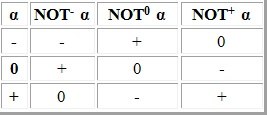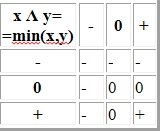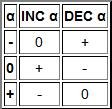Replacing binary logic - will it increase performance?
Surely on Habré already a lot of posts on this topic. Nevertheless, I will try to tell my point of view on all this ...
Once I read about the ternary number system on the Internet and became interested. I was tormented by the question, but it is impossible to use a symmetrical trinity system (CC) at the base of the computer, and even suddenly it will increase the computer performance? It seemed to me that it was possible, and I was eager to check it out.
Information:
The ternary number system is a positional number system with an integer base equal to 3. It exists in two versions: asymmetric and symmetric.
In the asymmetric ternary notation, the numbers {0,1,2} are more often used, and in the symmetric ternary notation, the signs {-, 0, +}, {−1.0, + 1} are used.
For some people, this logic causes difficulties. They say, for example, give an example of such logic in life.
A person who has a little thought over this logic will understand that it is more vital than binary. The usual example of the ternary logic in life is connected with direct current: the current moves in one direction, in the other direction, it does not exist.
')
It turned out that the symmetric ternary number system was used a long time ago to solve the "problem of kettlebells", was used in the computer Setun , built in the 50s at MSU. Since 2008, the TCA2 digital computer system based on the ternary number system has been operating at the California Polytechnic State University of San Luis Obispo.


What are the advantages of the ternary SS above the binary? Consider these advantages:
Take the number 10 in decimal CC and translate it into binary CC, get 1010, translate into ternary symmetric SS, get +0+, well, if in ternary asymmetrical SS, we get 101. From this we see that in some numbers in ternary symmetric and asymmetric SS-ah less discharges than in the binary SS.
Take the number 5 in decimal CC and translate it into binary CC, get 101, translate into ternary symmetric SS, then we get + -, well, if we get into ternary asymmetrical SS, we get 12. From this we see that in some numbers the ternary asymmetric SS is less discharges than in the binary and ternary symmetric SS-ah.
Trinity CC contains a larger range of numbers, since 3 ^ n> 2 ^ n (where n is a natural number). For example, if n = 9, then 3 ^ 9 = 19683> 2 ^ 9 = 512.
3
The efficiency of the number system is a supply of numbers that can be written in this system with the help of a certain number of characters. The larger the stock, the more economical the system. In terms of the cost of the number of characters (in a three-digit decimal number 3 * 10 = 30 characters), the most economical of positional exponential asymmetric number systems. Denote by p the base of the number system, n is the number of characters required. Then we get n / p digits required to write this set of characters in a given number system, and the number of numbers that can be written in this case will be equal to pn / p.
We have considered the ternary arithmetic, now we will touch on the logic:
What are the problems of binary logic?
1. The power of a computer based on binary logic is not always enough. Let's give an example. One of the most complex security systems is the RSA cryptosystem. Opening the RSA cipher with a key length of 1024 bits (this length is often used in information systems) will take, at best, when performing distributed computing on thousands of powerful PCs, for at least fifteen years, and by that time this encryption system will no longer be in demand.
We prove mathematically which number system is best for maximum power and memory capacity. To do this, consider the function f (p) = p ^ (n / p), in which p is the base of the number system, and n is the number of required characters. Then we get n / p digits required to write this set of characters in a given number system, and the number of numbers that can be written in this case will be equal to pn / p
f (p) = p ^ (n / p)
In order to determine the maximum value of the function, we find its derivative:
ln f = ln p ^ (n / p)
ln f = n / p * ln p
... (I will not give all the math here)
n * p ^ (n / p-2) will never be 0 => (1 - ln p) = 0, ln p = 1, p = e
e = 2.71, and the nearest integer to it is three.
So, in this regard, the best system with an integer base is threefold.
The most delicious - consider the ternary logical operations:
1. Negation

2. Conjunction - logical AND

3. Disjunction - logical OR

4. Operation Choice . This operation exists only for ternary logic. The truth table of each of these three operations contains everywhere "-", except for the only value that it can choose.

5. Modification . The full name of these single operations is one unit modulo three (INC) and one unit modular three (DEC). An increase of one modulo three is a cyclic addition of one.

Here you can see the logical logic operations familiar to you from binary logic, but new ones were added ...
Quantum computer is a computing device operating on the basis of quantum mechanics. A quantum computer is fundamentally different from classic computers based on classical mechanics.
Due to the enormous speed of decomposition into prime factors, a quantum computer will allow decrypting messages encrypted using the popular asymmetric cryptographic algorithm RSA. Until now, this algorithm is considered relatively reliable, since the effective method of decomposing numbers into prime factors for a classical computer is currently unknown. In order, for example, to gain access to a credit card, you need to expand a number of hundreds of digits into two simple factors. Even for the fastest modern computers, this task would take hundreds of times more than the age of the Universe. Thanks to Shor's algorithm, this task becomes quite feasible if a quantum computer is built.
The Canadian company D-Wave announced in February 2007 the creation of a sample quantum computer consisting of 16 qubits. This device works on qubits - quantum analogs of bits.
But it is possible to build computers not on bits, but on qutrits — analogues of trit in a quantum computer.
Qutrit (quantum trite) is a quantum cell with three possible states.
The genuine innovation of the Lannion method is that by using quutrites instead of qubits in universal quantum gates, researchers can significantly reduce the number of gates needed.
Lannion argues that a computer that would normally have used 50 traditional quantum gates would be able to do with just nine, if it is based on a three-way representation.
Also, according to some studies, the use of qutrites instead of qubits will simplify the implementation of quantum algorithms and computers.
Total:
In the end, it can be seen that the ternary symmetric system is better than the binary system in some indicators, but it does not win much. But with the advent of quantum computers, ternary computing got a new life. Universal quantum logic gates — the cornerstone of newborn quantum computing systems — require hundreds of gates to complete one useful operation. The quantum computer of the Canadian company D-Wave, announced last year, consists of only 16 quantum bits - qubits - the minimum necessary for a controlled “NOT” gate. Using a quantum computer in a quantum computer would require much fewer gates to complete a single operation. I think if the production and testing of such computers began, the results would be better than those of ordinary computers, their mass production would soon begin, and everyone would forget about binary computers ...
Once I read about the ternary number system on the Internet and became interested. I was tormented by the question, but it is impossible to use a symmetrical trinity system (CC) at the base of the computer, and even suddenly it will increase the computer performance? It seemed to me that it was possible, and I was eager to check it out.
Information:
The ternary number system is a positional number system with an integer base equal to 3. It exists in two versions: asymmetric and symmetric.
In the asymmetric ternary notation, the numbers {0,1,2} are more often used, and in the symmetric ternary notation, the signs {-, 0, +}, {−1.0, + 1} are used.
For some people, this logic causes difficulties. They say, for example, give an example of such logic in life.
A person who has a little thought over this logic will understand that it is more vital than binary. The usual example of the ternary logic in life is connected with direct current: the current moves in one direction, in the other direction, it does not exist.
')
It turned out that the symmetric ternary number system was used a long time ago to solve the "problem of kettlebells", was used in the computer Setun , built in the 50s at MSU. Since 2008, the TCA2 digital computer system based on the ternary number system has been operating at the California Polytechnic State University of San Luis Obispo.


What are the advantages of the ternary SS above the binary? Consider these advantages:
Less discharges
(It is written chewed so that everyone can understand the essence of this item)Take the number 10 in decimal CC and translate it into binary CC, get 1010, translate into ternary symmetric SS, get +0+, well, if in ternary asymmetrical SS, we get 101. From this we see that in some numbers in ternary symmetric and asymmetric SS-ah less discharges than in the binary SS.
Take the number 5 in decimal CC and translate it into binary CC, get 101, translate into ternary symmetric SS, then we get + -, well, if we get into ternary asymmetrical SS, we get 12. From this we see that in some numbers the ternary asymmetric SS is less discharges than in the binary and ternary symmetric SS-ah.
Capacity
Trinity CC contains a larger range of numbers, since 3 ^ n> 2 ^ n (where n is a natural number). For example, if n = 9, then 3 ^ 9 = 19683> 2 ^ 9 = 512.
3
Efficiency of the number system
The efficiency of the number system is a supply of numbers that can be written in this system with the help of a certain number of characters. The larger the stock, the more economical the system. In terms of the cost of the number of characters (in a three-digit decimal number 3 * 10 = 30 characters), the most economical of positional exponential asymmetric number systems. Denote by p the base of the number system, n is the number of characters required. Then we get n / p digits required to write this set of characters in a given number system, and the number of numbers that can be written in this case will be equal to pn / p.
We have considered the ternary arithmetic, now we will touch on the logic:
What are the problems of binary logic?
1. The power of a computer based on binary logic is not always enough. Let's give an example. One of the most complex security systems is the RSA cryptosystem. Opening the RSA cipher with a key length of 1024 bits (this length is often used in information systems) will take, at best, when performing distributed computing on thousands of powerful PCs, for at least fifteen years, and by that time this encryption system will no longer be in demand.
We prove mathematically which number system is best for maximum power and memory capacity. To do this, consider the function f (p) = p ^ (n / p), in which p is the base of the number system, and n is the number of required characters. Then we get n / p digits required to write this set of characters in a given number system, and the number of numbers that can be written in this case will be equal to pn / p
f (p) = p ^ (n / p)
In order to determine the maximum value of the function, we find its derivative:
ln f = ln p ^ (n / p)
ln f = n / p * ln p
... (I will not give all the math here)
n * p ^ (n / p-2) will never be 0 => (1 - ln p) = 0, ln p = 1, p = e
e = 2.71, and the nearest integer to it is three.
So, in this regard, the best system with an integer base is threefold.
The most delicious - consider the ternary logical operations:
1. Negation

2. Conjunction - logical AND

3. Disjunction - logical OR

4. Operation Choice . This operation exists only for ternary logic. The truth table of each of these three operations contains everywhere "-", except for the only value that it can choose.

5. Modification . The full name of these single operations is one unit modulo three (INC) and one unit modular three (DEC). An increase of one modulo three is a cyclic addition of one.

Here you can see the logical logic operations familiar to you from binary logic, but new ones were added ...
Quantum computers
Quantum computer is a computing device operating on the basis of quantum mechanics. A quantum computer is fundamentally different from classic computers based on classical mechanics.
Due to the enormous speed of decomposition into prime factors, a quantum computer will allow decrypting messages encrypted using the popular asymmetric cryptographic algorithm RSA. Until now, this algorithm is considered relatively reliable, since the effective method of decomposing numbers into prime factors for a classical computer is currently unknown. In order, for example, to gain access to a credit card, you need to expand a number of hundreds of digits into two simple factors. Even for the fastest modern computers, this task would take hundreds of times more than the age of the Universe. Thanks to Shor's algorithm, this task becomes quite feasible if a quantum computer is built.
The Canadian company D-Wave announced in February 2007 the creation of a sample quantum computer consisting of 16 qubits. This device works on qubits - quantum analogs of bits.
But it is possible to build computers not on bits, but on qutrits — analogues of trit in a quantum computer.
Qutrit (quantum trite) is a quantum cell with three possible states.
The genuine innovation of the Lannion method is that by using quutrites instead of qubits in universal quantum gates, researchers can significantly reduce the number of gates needed.
Lannion argues that a computer that would normally have used 50 traditional quantum gates would be able to do with just nine, if it is based on a three-way representation.
Also, according to some studies, the use of qutrites instead of qubits will simplify the implementation of quantum algorithms and computers.
Total:
In the end, it can be seen that the ternary symmetric system is better than the binary system in some indicators, but it does not win much. But with the advent of quantum computers, ternary computing got a new life. Universal quantum logic gates — the cornerstone of newborn quantum computing systems — require hundreds of gates to complete one useful operation. The quantum computer of the Canadian company D-Wave, announced last year, consists of only 16 quantum bits - qubits - the minimum necessary for a controlled “NOT” gate. Using a quantum computer in a quantum computer would require much fewer gates to complete a single operation. I think if the production and testing of such computers began, the results would be better than those of ordinary computers, their mass production would soon begin, and everyone would forget about binary computers ...
Source: https://habr.com/ru/post/166679/
All Articles